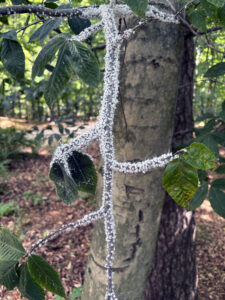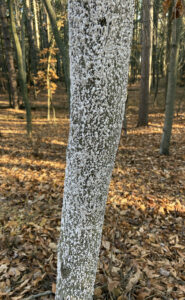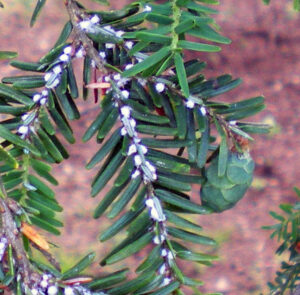
Beech blight aphids are found on a beech twig at Kohler-Andrae State Park in Sheboygan County, Sept 5, 2025. / Photo Credit: Wisconsin DNR
By Bill McNee, DNR Forest Health Specialist, Oshkosh
Bill.McnNe@wisconsin.gov
Late summer and fall is the time of year when fluffy “beech blight aphids” become very noticeable on American beech trees (Fagus grandifolia) in the eastern quarter of Wisconsin, where the tree species occurs.
These large aphids grow white, waxy filaments from their abdomens and feed in a colony on the branches of beech trees. When disturbed, they all shake their abdomens in an attempt to scare off predators. This behavior has led to the insect being commonly known as the “boogie woogie aphid.”
High populations of beech blight aphid usually do not harm a tree, being a late-season pest only abundant on scattered branches. Twig and small branch dieback may occur. A strong stream of water can be used to dislodge the aphids from an infested branch. Insecticide application is typically unnecessary.
Similar insects may be found on other tree species. Woolly alder aphid is common on alders and also has a “fluffy” appearance.

Dense “white wool” of beech scale on the trunk of a beech tree at Kohler-Andrae State Park, November 2023. / Photo Credit: Wisconsin DNR
Several woolly insects often seen in Wisconsin have a more compact “cotton ball” appearance. Beech scale, the insect associated with beech bark disease, is covered in white wool and remains visible on the trunk of a beech tree throughout the year. Pine bark adelgid is often spotted on pines.
Other woolly insects that have yet to be detected in the state are:

A woolly appearance of hemlock wooly adelgid at the base of hemlock needles in Maryland. This invasive pest has yet to be detected in Wisconsin. / Photo Credit: Wisconsin DNR
- Hemlock woolly adelgid (HWA) is an invasive insect that attacks hemlock. Heavy populations of HWA can cause decline and mortality of hemlocks.
- Balsam woolly adelgid (BWA) is an invasive insect that attacks true firs, including balsam fir. These tiny insects can be found on the main stem as well as on twigs.
If you think you’ve found either of these adelgids on hemlock or fir, please take clear, close-up and wider-view photos and send them to your DNR Forest Health specialist.
